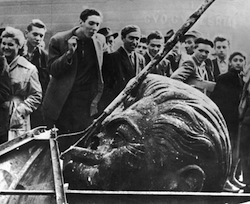The first time people hear my last name, they often screw up their faces and ask: “Pataki? What type of a name is that?” Or, something along those lines. People have guessed Polish. Italian. Even Japanese. But no, my last name is Hungarian.
 Because my family is Hungarian, the big anniversary that has been commemorated over the past couple of weeks has been important for us. We just marked the fifty-seventh anniversary since the Hungarian Revolution, the first major uprising in Eastern Europe against the Soviet Union and its totalitarian policies.
Because my family is Hungarian, the big anniversary that has been commemorated over the past couple of weeks has been important for us. We just marked the fifty-seventh anniversary since the Hungarian Revolution, the first major uprising in Eastern Europe against the Soviet Union and its totalitarian policies.
It was a devastating series of events that left thousands of Hungarians dead and forced hundreds of thousands more to flee as refugees. It was a David and Goliath story. One eyewitness report always gives me chills – the story of the tanks rolling into Hungary from the east. A little child wanted to cross the street to get to the other side of his village, but his mother made him wait on the side of the road for a passing tank. That tank passed. And then another. And then another one after that. The train of tanks continued to pass for hours and hours. They kept coming, from Moscow toward Budapest, for the entire day.
So here are the broad strokes in the conflict that LIFE called “the first crack in the Iron Curtain.” In late October of 1956, the Hungarians rose up and ousted the highly repressive Soviet-sanctioned regime, along with its brutal secret police force, from Budapest. Here you see the people in the capital after they tore down the massive statue of Stalin. They then installed a new government that reflected the will of the people. And the Soviets wavered, uncertain of whether or not to intervene using force. The Politburo in Moscow was divided.
Weeks passed and the Hungarians moved forward with their new, popularly-appointed government. They re-established free speech and the freedom of the press. They made overtures to the West for recognition and support. Meanwhile, back in Moscow, the hardliners won the internal debate. The Soviet leadership, under Nikita Khrushchev, decided to respond to Hungary with force. And it would be a force punishing enough to teach the other satellites a lesson about the consequences of dissension.
I’m going to link here to the LIFE photos of the Hungarian Revolution, which I found on Life.time.com, because I think they tell the story best.
Walking through Budapest today, you can’t help but be impressed by its beautiful architecture. There’s the famous Chain Bridge. The whimsical Fisherman’s Bastion. The Church of St. Matthew up on Buda Hill. But you also see the bullet holes, scars that still mark the buildings, telling the story of what happened there fifty seven years ago.




